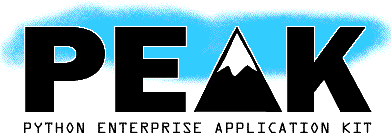








Ignore changes in the amount of whitespace
Differences between version dated 2005-03-23 19:58:11 and 2007-03-26 19:17:30
(spanning 5 versions)
Deletions are marked like this.
Additions are marked like this.
Suppose we have an existing application component which we want to make accessible over the web.
This shows a simple component producing an infinite series of text slides::
This shows a simple component producing an infinite series of text slides. Create the file ``slides.py`` and paste this content::
#!python
import sys
from urllib import quote
import protocols
import peak.web.templates
from peak.api import binding, config, naming, security, web
from peak.running.interfaces import IRerunnable
from peak.tools.local_server import WSGIServer
if __name__ == "__main__":
main()
Normally, DOMlet handlers are registered in section ``peak.web.werbs`` of PEAK configuration file like this::
Normally, DOMlet handlers are registered in section ``peak.web.verbs`` of PEAK configuration file like this::
[peak.web.verbs]
when-larch = pwt.negotiatorFactory(my.module.WhenLarch)
In this example, we have only one (root) location with two views: ``index_html``, displaying our application component, and ``larch``, publishing a static file from resource package.
Finally we need to have the current directory in an importable path::
$ export PYTHONPATH=.
And now... the script to run all this::
#!python
if __name__ == "__main__":
main()
There is near to zero web code in this script! If our sitemap knew where to take the component it publishes (i.e. if we used valid import specifications in ``container object`` and ``content type``), we wouldn't need our launch script at all. Sitemap may be run by itself with PEAK command line tool::
There is near to zero web code in this script! If our sitemap knew where to take the component it publishes (i.e. if we used valid import specifications in ``container object`` and ``content type``), we wouldn't need our launch script at all. To do so we first need to change our ``sitemap.xml``::
<location id="root" config="resources.ini">
<import module="slides" />
<container object="slides.Slides()" />
<content type="slides.ISlides">
<view name="index_html" resource="templates/slide"/>
<view name="larch" resource="templates/larch.jpg"/>
</content>
</location>
Notice the import of the module ``slides``, wich is our original ``slides.py``. Next we need to start the server using the ``sitemap.xml``, we use the command ``serve`` to do
it. There is a special flag ``-p <PORT>`` to specify the port we want our webserver to listen to. Finally we run peak as the following::
$ peak serve ref:sitemap@file:sitemap.xml
$ peak serve -p 8917 ref:sitemap@file:sitemap.xml
or, to automatically launch web browser displaying our application::
If the sitemap was located inside a Python package directory we could specify it using a ``pkgfile:`` URL in place of a ``file:`` URL. For example, if the sitemap file was in the package directory for a package named ``some.package``, we could launch the web browser displaying our application::
$ peak launch ref:sitemap@pkgfile:my.module/sitemap.xml
$ peak launch ref:sitemap@pkgfile:some.package/sitemap.xml
(in the later example sitemap is located in python package ``my.module``).
(The ``peak serve`` command just starts a web server. The ``peak launch`` command is similar, but also launches a web browser to display the root of the application -- a convenient development tool.)


